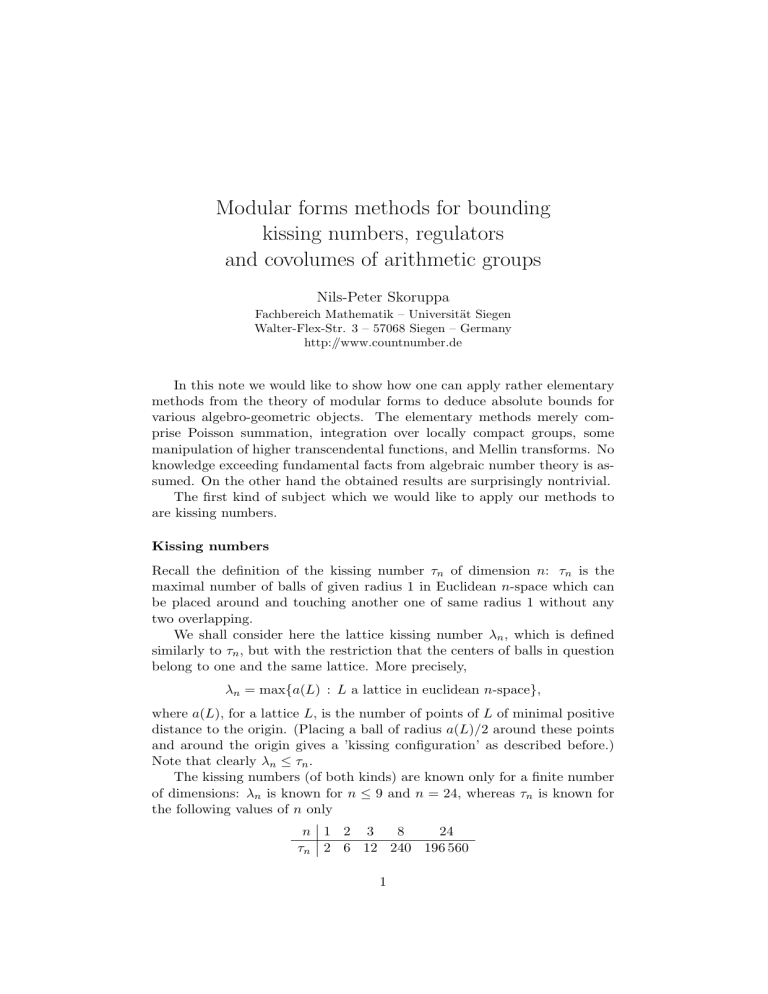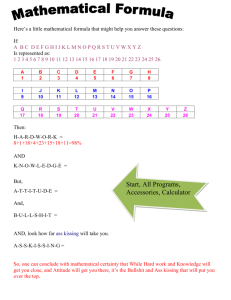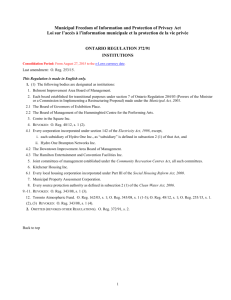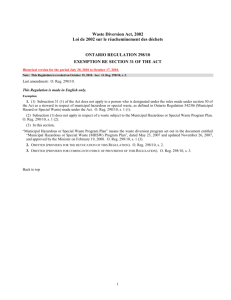Modular forms methods for bounding kissing numbers, regulators
advertisement

Modular forms methods for bounding
kissing numbers, regulators
and covolumes of arithmetic groups
Nils-Peter Skoruppa
Fachbereich Mathematik – Universität Siegen
Walter-Flex-Str. 3 – 57068 Siegen – Germany
http://www.countnumber.de
In this note we would like to show how one can apply rather elementary
methods from the theory of modular forms to deduce absolute bounds for
various algebro-geometric objects. The elementary methods merely comprise Poisson summation, integration over locally compact groups, some
manipulation of higher transcendental functions, and Mellin transforms. No
knowledge exceeding fundamental facts from algebraic number theory is assumed. On the other hand the obtained results are surprisingly nontrivial.
The first kind of subject which we would like to apply our methods to
are kissing numbers.
Kissing numbers
Recall the definition of the kissing number τn of dimension n: τn is the
maximal number of balls of given radius 1 in Euclidean n-space which can
be placed around and touching another one of same radius 1 without any
two overlapping.
We shall consider here the lattice kissing number λn , which is defined
similarly to τn , but with the restriction that the centers of balls in question
belong to one and the same lattice. More precisely,
λn = max{a(L) : L a lattice in euclidean n-space},
where a(L), for a lattice L, is the number of points of L of minimal positive
distance to the origin. (Placing a ball of radius a(L)/2 around these points
and around the origin gives a ’kissing configuration’ as described before.)
Note that clearly λn ≤ τn .
The kissing numbers (of both kinds) are known only for a finite number
of dimensions: λn is known for n ≤ 9 and n = 24, whereas τn is known for
the following values of n only
n 1 2 3
8
24
τn 2 6 12 240 196 560
1
For these five n one has τn = λn , but it is known that τ9 < λ9 . For all this
and more details see [Con-Slo], p.23.
For arbitrary n one has the following asymptotic bound ([Kab-Lev]):
τn ≤ 20.401 (n(1+o(1)) ≤ 1.32043n(1+o(1)) .
The original proof of Kabatiansky-Levenshtein is quite complicated. But
here is a short proof which shows how one can obtain such type of asymptotic
bound rather easily, however, only for lattice kissing numbers.
Let L be a lattice in Euclidean n-space. For positive real t set
X
2
θ(t) = θL (t) =
e−πtx = 1 + a(L)t−πrt + . . . ,
x∈L
where r is the smallest non-zero length of points in L. For bounding a(L) we
can and will assume, after rescaling L if necessary, that r = 1 .he function
θ(t) is obviously decreasing in t. On the other hand, tn/2 θ(t) is increasing.
Indeed, this follows on using Poisson summation
θ(t)tn/2 = det(L)−1 θL∗ (1/t)
(L∗ denoting the dual lattice og L.) On taking the derivative we thus find
0≤
X
n
d
2
θ(t)tn/2 =
− πtx2 + tn/2−1 e−πtx .
dt
2
x∈L
For
n
,
2
all terms in the last sum but the first are negative, and on dropping those
with x2 > 1 we obtain
u := πt ≥
a(L)(u −
n −u n
)e ≤ .
2
2
The left hand side takes its maximum for u =
range), and hence we find
a(L) ≤
n
2
+ 1 (which is in the valid
n n +1
e2 .
2
For example, a(L) ≤ 2, 7, 18 for n = 1, 2, 3. In any case we have proved
Theorem.
n
λn ≤ e 2 (1+o(1)) ≤ 1.65n(1+o(1)) .
This is not as sharp as the Kabatiabski-Levenstein bound. However, we
shall indicate in a moment how a refinement of the above method could be
used to prove a much sharper asymptotic bound. The idea is roughly to
2
replace the exponential function in the definition of θ by another function
which reduces the error made when discarding the terms with x2 > 1. For
this it seems to be easier to pass to Dirichlet series, i.e. to apply Mellin transformation, since the higher transcendental functions have usually simple
Mellin transforms, e.g. ratios of products of Gamma functions with shifted
arguments. We shall illustrate these techniques in more precise terms in the
next section 1 .
We end this section by noting in passing that the above arguments,
applied to a modular form, say on the full modular group, yield a quick
proof of the following result2 :
An (elliptic) cusp form on the full modular group has positive as well as
negative Fourier coefficients.
Regulators
Possibly the most mysterious and subtle elements of a number fields are the
units. They show a rather paradoxical behavior. Sometimes the have a high
complexity:
√
K = Q( 611953), Z∗K = ±εZ , ε2 − mε − 1,
where m is a natural number with 499 digits. (We use ZK for the ring of
integers of K.) Sometimes they have a small complexity, which can cause
problems too: for the height
Y
H(α) =
max(1, |α0 |)
α0 conjugate to α
of an algebraic integer it is conjectured that there is an absolute constant
C > 1 such that
H(α) ≥ C
for all α 6= 0 which are not roots of unity (Lehmer conjecture [Lehm]). The
numbers for which this conjecture is open are the non reciprocal units i.e.
units α which are conjugate to 1/α, and among these those with very small
height occur among the Salem numbers, which are by definition positive
real self reciprocal units α whose conjugates, apart from 1/α, lie on the unit
circle |z| = 1.
An important measure for a group of units are the regulators. We consider here as an example relative regulators: Let L/K be an extension of
number fields, and let
E = EL/K := {ε ∈ Z∗L : NL/K (ε) = root of unity},
1
Don Zagier pointed out that the theory of Ferrar transforms should provide the correct
framework for this cycle of ideas.
2
We would be grateful for a pointer to the literature where this simple fact (without
doubt at least unconsciously known to the reader) is explicitly stated.
3
be the group of relative units of this extension. It is easy to show that the
rank of E is
s := rank(E) = #PL − #PK ,
where PK is the set of Archimedean places of K (and similarly for PL ). Let
εj (1 ≤ j ≤ s) be a system of fundamental units of L/K, i.e. the εj T form a
Z-basis for E/T with T denoting the torsion subgroup of E. For each place
v of K pick a place ve of L extending v, and let vj (1 ≤ j ≤ s) be the places
of L different from all the ve. Set ev = 1 or ev = 2 accordingly as v is real or
complex. The relative regulator is then defined to be
Reg(L/K) := det evk · log |εh |vk
.
1≤h,k≤s
Here the absolute values |α|v associated to v are normalized such that
Y
|NL/Q (α)| =
|α|evv .
v∈PL
If ε is a Salem number, then
n
Reg Q(ε)/Q(ε + 1/ε) = log |ε|
2
with a suitable positive integer n [Chi]. Moreover, it is easy to prove that
Reg(L)
≥ Reg(L/K).
Reg(K)
Thus it is interesting to derive lower bounds for relative regulators.
For the regulator Reg(L) = Reg(L/Q) of an arbitrary number field L it
is known:
Theorem. ([Zim], 1981)
Reg(L)
≥ .02 · exp(0.46 r1 + 0.1 r2 )
wL
Here r1 and r2 denote the real and complex places of K.
Moreover it is conjectured (Conjecture of Martinet and Bergé): There
are absolute constants C1 > 0 and C2 > 1 such that
[L:K]
Reg(L/K) ≥ C0 C1
.
One can derive such bounds by generalizing the method which we used
before for the kissing numbers. For this consider ER = E ⊗ R as submodule
of RP+L via the embedding
ER = E ⊗ R → RP+L ,
4
ε ⊗ 1 7→ |ε|v .
Here R+ is the (multiplicative) group of positive real numbers. For α ∈ K
and x ∈ RP+L let
X
ev |α|2v x2v .
σ(α, x) =
v∈PL
Note that
σ(εα, x) = σ(α, (ε ⊗ 1)x)
for all ε ∈ E. Usual Poisson summation gives
Y
X
X
exp(−πtσ(a, x)) = |DL |−1/2
tn/2
xevv
exp(−πt−1 σ(a, x−1 ))
v∈PL
α∈ϑ−1
L
α∈ZL
(where DL and ϑL denote the discriminant and different of L, respectively).
Here x ∈ RP+L , t > 0, and n = [L : Q]. Note that both sides, as functions of
x, are invariant under E. Hence, by integrating over a fundamental domain
ER /E and the usual trick of “unfolding” the integral, we obtain
tn/2
X Z
µ(ER /E)
+ tn/2
exp(−πtσ(a, x)) dµ(x)
#Etor
ER
α∈ZL /E
α6=0
= |DL |−1/2
µ(ER /E)
+ |DL |−1/2
#Etor
X
α∈ϑ−1
L /E
α6=0
Z
exp(−πt−1 σ(a, x)), dµ(x).
ER
Here µ denotes any Haar measure on ER . A natural normalization of µ is
the usual Lebesgue measure on ER , and then one obtains
µ(ER /E) = Reg(L/K).
Now one can proceed as with the kissing numbers to derive a lower
bound for the relative regulator: the left hand side of the last identity is an
increasing function, and taking its derivative gives the inequality
X Z 2u
µ(ER /E)
≥
σ(a, x) − 1 exp(−u σ(a, x)) dµ(x)
#Etor
n
ER
α∈ZL /E
α6=0
for all u (= πt) > 0. The summands occurring in this inequality are much
more complicated than the exponential function and their study is quite
cumbersome. Nevertheless, the procedure applied to the kissing numbers
before, i.e. dropping all terms with α 6= 1 for u large enough and maximizing
in u, can be pushed through and gives:
Theorem. ([Fri-Sko 1], 1999) One has
[L:K] [K:Q]
Reg(L/K) ≥ d0 d1
(d0 = (0.1/1.15)39 , d1 = 1.15)
5
As a consequence, the conjecture of Martinet-Bergé holds true at least
for [L : K] 0.
For K = Q, i.e. for the non relative case, one can obtain, without much
effort, a better result by applying Mellin transformation (for K 6= Q the
integrals in our last transformation formula have in general no reasonable
Mellin transform which would lead to usual Dirichlet series). For this denote
the left hand side of our last Poisson summation formula by
u
Reg(L)
+ f (u) ,
#Etor
where now u = tn/2 . It is well-known (this is Hecke’s Ansatz for the analytic
continuation and the functional equations of partial zeta functions) that, for
a suitable choice of µ, one has
Z ∞
X
dt
D∗ (s) :=
f (t)ts
= C s Γ(s/2)r1 Γ(s)r2
NL/Q (α)−s =: C s γ(s)D(s)
t
0
α∈ZL
α6=0
(for s > 1). Here C is a positive constant, whose exact value is not important
in the following reasoning. Moreover
Ress=0 D∗ (s) = −
2r1 Reg(L)
,
w
where w denotes the number of roots of unity in L. Set
g(s) := log s(s − 1)D∗ (s);
then
2r1 Reg(L)
.
w
Assume that g(s), for s > 1, satisfies the following convexity property:
g(0) = log
g(s) − g(0)
≤ g 0 (s), i.e. g(0) ≥ g(s) − sg 0 (s).
s
Unfortunately, we do not know any obvious reason why this should hold
true. Nevertheless, this inequalities are indeed correct, as we shall show in
a moment. Taking exponentials in the last inequality we obtain
Reg(L)
s(s − 1)
s
γ0
D0 ≥
γ(s)D(s)
exp
−
1
−
−
s
(s)
−
s
(s) .
w
2r1
s−1
γ
D
0
Using D(s) > 1 and − D
D (s) > 0 we obtain the following lower bounds:
s(s − 1)
s
γ0 Reg(L)
≥
γ(s)
exp
−
−
s
(s) .
w
2r 1 e
s−1
γ
Choosing s = 4/3 we find:
6
Theorem. ([Sko 1], 1993)
Reg(L) ≥ 0.00299 · exp(0.48 r1 + 0.06 r2 ).
It remains to prove the convexity property.
Lemma.R Assume that f : R+ → R satisfies f ≥ 0, that the Mellin transform
∞
Z(s) := 0 f (t)ts dtt converges for s > 1 and that t(C + f (t)) is increasing
for some constant C. Then
C≥
s(s − 1)
s
Z0 Z(s) exp −
− s (s) .
e
s−1
Z
Proof. Set
log+ (t) := log max(1, t),
w(t) := t log+ (1/t).
Note w(t) = 0 for t > 1 and w0 (t) = −(1 + log t) for t < 1. The function
Z ∞
dt
I(a) :=
(C + f (t))t w (at)s−1
t
0
is decreasing in a (set t/a 7→ t) since t(C +f (t)) is increasing by assumption.
Thus I 0 (a) ≤ 0, i.e.
Z ∞
dt
(C + f (t))ts w0 (at)s−1
t
0
(the reader may verify by himself that the discontinuity of w0 (t) at t = 1
can indeed be ignored). Inserting the formula for w0 (t) then gives
Z 1/a
Z 1/a
dt
dt
≥−
f (t)ts 1 + (s − 1) log(at)
≥
C
ts 1 + (s − 1) log(at)
t
t
0
0
Z ∞
dt
−
f (t)ts 1+(s−1) log(at)
= −(1+(s−1) log a)Z(s)−(s−1)Z 0 (s).
t
0
Choosing
log a = −
1
1
Z0
d
log s(s − 1)Z(s) = − −
− (s)
ds
s s−1
Z
gives the desired inequality.
A variation of the last lemma may be applied to the kissing number
problem. For this we replace the exponential function in the definition of
the theta series considered in the first section by a suitable Bessel function.
More precisely, we start with the identity
X
X
t
F (t1/n |x|) = c0
max 0, (1 − t−2/n x2 )p ,
x∈L
x∈L∗
7
where
F (t) = Jq−1 (2πt)/tq−1 , q =
n
+ p + 1.
2
Here we have to assume q > n + 12 (to assure that the series on the left
converges absolutely), and c0 is a positive constant, whose precise value is
not important. Writing the left hand side in the form t(C + f (t)) we find
C = π q−1 /Γ(q) and, for the Mellin transform of f (t), the formula
X
n q−1−ns Γ ns
2
π
(x2 )−s .
ns
2
Γ q − 2 x∈L
c6=0
Applying the inequality of the preceeding lemma and using in the same
manner as before
D(s) :=
X
(x2 )−s ≥ a(L),
x∈L
c6=0
D0
(s) < 0,
D
we obtain an estimate to above for a(L).
Unfortunately we cannot apply the preceeding lemma literally, since f (t)
is not nonnegative. However, it is still possible to prove a similar lemma for
not necessarily nonnegative functions f (and for the price of a slightly weaker
inequality). With a suitable choice of q and s we are finally able to deduce:
Theorem. λn ≤ 1.359n(1+o(1)) .
For a detailed proof the reader is referred to [Sko 2].
We do not know whether the sketched method is suited (with a more
clever choice of the function F (t)) to deduce an asymptotic bound as sharp
as the one of Kabatiansky-Levenshtein or even interesting bounds in specific
dimensions.
Covolumes
We conclude this report by speculating about further applications of the
ideas sketched so far. The following theorem is known:
Theorem. (Kajdan-Margoulis) Let G be a semi-simple connected Lie group
without compact factors (i.e. without any nontrivial compact connected subgroup), and let µ be a Haar measure on G. Then there is a constant cµ such
that, for all discrete subgroups Γ of G, one has µ(G/Γ) ≥ cµ .
It should be possible to obtain such bounds, in the case of arithmetic
subgroups, by generalizing the ideas of the preceeding sections. The starting point would be as before a suitable Poisson summation type formula
involving µ(G/Γ).
8
To become more precise, let G be a locally compact
discrete subgroup. Suppose that G acts on an Euclidean
which contains a lattice L stable under the action of Γ.
summation and the method of unfolding the integral one
generalized Poisson summation formula of the form
µ(G/Γ)vf (0) + v
X
x∈L/Γ
x6=0
group and Γ a
space (E, h , i)
Using Poisson
would expect a
1
f (x)
|Γx |
= µ(G/Γ)v ∗ fe(0) + v ∗
X
y∈L∗ /Γ∗
y6=0
1 e
f (y).
|Γ∗y |
Here f is a G-invariant function on E, we use L∗ for the dual lattice of L with
respect to h , i, and v = vol(E/L)1/2 , v ∗ = vol(E/L∗ )1/2 . Moreover, L∗ /Γ∗
means the set of orbits with respect to the action of the g ∗ (g ∈ Γ), where the
star indicates dual action on E, i.e. the action defined by hg ∗ x, yi = hx, g −1 yi
for all x, y. Similarly Γ∗y is the stabilizer of y with respect to the the dual
action of Γ. Finally, the function fe is an integral transform which does
not depend on Γ or L, but depends only on G and the choice of the Haar
measure µ, which also defines the covolume µ(G/Γ).
Suitable choices of f and following the procedure sketched for the bounds
for relative regulators, would then yield lower bounds for µ(G/Γ).
It is clear that such a generalized Poisson summation formula will be
valid only under suitable hypothesis on f and on the action of G, whose
precise formulation needs a careful analysis. The case of the orthogonal
group G = O(V ) is well-known and almost trivial: here fe is essentially a
Hankel transform. The case where Γ is the group of units relative to an
extension of number fields L/K modulo torsion, where G = Γ ⊗ R, and
where L is a fractional ideal of L, considered as sublattice of L ⊗Q R, is
treated in the following theorem (we use the notations introduced in the
preceeding section):
Theorem. ([Fri-Sko 2], 2000) Let L/K be an extension of number fields,
∗ | N
A an ideal of L, let E := {ε ∈ OL
L/K (ε) root of unity of K}, and PK
be the set of Archimedean places of K. Then, for all smooth and compactly
supported functions f : RP+K → C, one has
X
α∈A/E α6=0
f
Z
2r1 (2π)r2 Reg(L/K)
p
=
f (y) dy
v∈PK
PK
|DL | NL/Q (A)wL R+
X
2r 2
+p
fe |NL/K (α)|v v∈P ,
K
|DL | NL/Q (A)
−1 −1
|NL/K (α)|v
α∈A
9
ϑL /E
α6=0
where
fe(y) = π [L:Q]/2
Z
P
f (x)
R+K
Y
kpv ,qv (xv yv ) dy.
v∈AK
Here, for v ∈ PK we use pv , qv for the number of real√and complex places
of L extending v, and kp,q (t) = ( √2π cos(πt))∗p ∗ J0 (4π t)∗q (the ∗ denotes
Mellin convolution).
The assumption about f is too restrictive (in fact, it makes the sum on
the left finite) and must be reconsidered for real applications. However, the
theorem indicates a direction which may be worthwhile further investigations.
References
[Chi]
T. Chinburg, Salem numbers and L-functions, J. Number Theory
18 (1984), 213–214
[Con-Slo]
J.H. Conway and N.J.A. Sloane, Sphere packings, lattices and
groups, Springer Verlag, 1988.
[Fri-Sko 1] —, Relative Regulators of number fields, Invent. Math. 135
(1999), 115–144
[Fri-Sko 2] —, A Poisson summation formula for extensions of number fields,
J. London Math. Soc. (2) 61 (2000), 36–50
[Kab-Lev] G.A. Kabatiansky and V.I. Levenstein, Bounds for packings on
a sphere and in space, Problems of Information Transmission 14
(No. 1, 1978), 1–17
[Lehm]
D.H. Lehmer, Factorization of certain cyclotomic functions, Ann.
Math. 34 (1933), 461–479.
[Sko 1]
N-P. Skoruppa, Quick lower bounds for regulators of number
fields, Enseign. Math. 39 (1993), 137–141
[Sko 2]
—, Quick estimates for kissing numbers, preprint 1996, submitted.
[S-W]
Stein and Weiss, Introduction to Fourier analysis on Euclidean
spaces. Princeton University Press 1971
[Zim]
R. Zimmert Ideale kleiner Norm in Idealklassen und eine Regulatorabschätzung, Invent. Math. 62 (1981), 367—380
10





